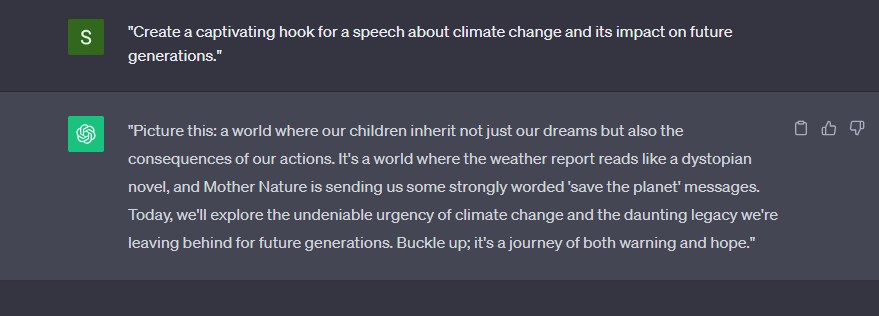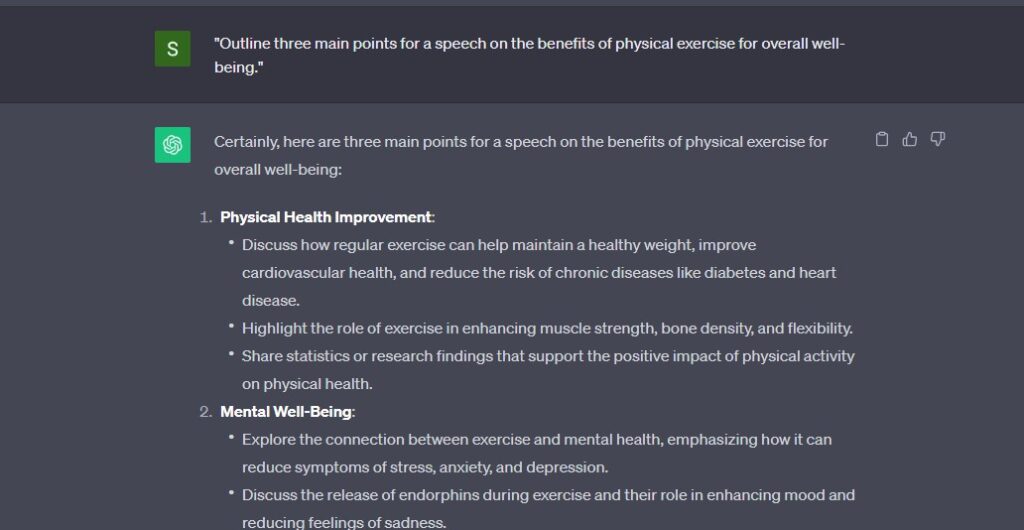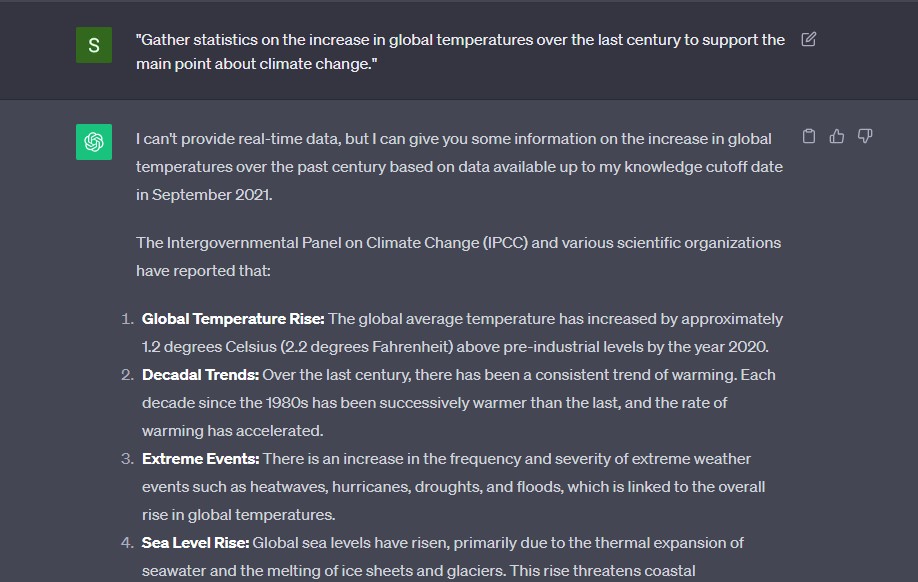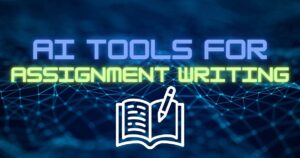ChatGPT Prompts For Speech Writing
The Essence of Engaging Speeches Engaging speeches have the power to captivate an audience, evoke emotions, and leave a lasting impression.
Engaging speeches are the linchpin of successful events, adding warmth and humor to the occasion, fostering connections, and generating unforgettable memories.
ChatGPT not only aids in overcoming writer’s block but also provides inspiration, creativity, and a helping hand in turning ideas into words.
But How to Use ChatGPT To Write A Speech? Isn’t ChatGPT generated content bland and pretentious? It can be but there is a way around.
By the end of this blog post, you’ll have a deeper understanding of how you can use ChatGPT to improve your speechwriting game, allowing you to craft speeches that touch hearts, evoke laughter, and create cherished memories.
Step By Step Guide To Write A Speech With ChatGPT
In the following paragraphs we will look into all the key ingredients of a killer speech and how can ChatGPT help us in being a better public speaker.
Writing an Engaging introduction
Introduction is the opportunity to make a strong first impression, capture the audience’s attention, and set the stage for what’s to come. The goal is to pique the audience’s curiosity, generate interest, and create a connection with your message.
Here’s an elaboration on various ways to craft an engaging introduction and some sample Chat GPT prompts that can be used in the openings:
Start with a Hook: A hook is a compelling statement or question that grabs the audience’s attention right from the beginning. Public speakers use it all the time.
“Create a captivating hook for a speech about climate change and its impact on future generations.”

Use Relevant Quote: A well-chosen quote can add authority and resonance to your speech.
“Find a meaningful quote about leadership to begin a speech on the qualities of a great leader.”
Share a Surprising Fact: Surprising facts or statistics can create a sense of intrigue and curiosity, making your audience eager to learn more.
“Provide a startling fact about the decline of biodiversity for an introduction to a speech on conservation efforts.”
Tell a Personal Anecdote: Sharing a personal story or experience related to your topic can make your speech relatable and emotionally engaging.
“Share a personal anecdote about a moment of personal growth to start a speech on self-improvement.”
Pose a Rhetorical Question: A rhetorical question can stimulate the audience’s thinking and encourage them to reflect on the topic.
“Craft a thought-provoking rhetorical question to open a speech about the future of technology and human relationships.”
Set the Scene: Paint a vivid picture for your audience by describing a scene or scenario that relates to your speech’s theme.
“Create a scene-setting description of a bustling city street to introduce a speech on urban development and sustainability.”
Use Humor: A well-timed and light-hearted joke or humorous anecdote can break the ice and connect with the audience.
“Craft a witty one-liner to kick off a speech about the importance of humor in everyday life.”
Start with a Paradox or Contradiction: Presenting a paradox or contradiction can intrigue the audience and provoke thought.
“Introduce a speech on the complexities of human nature by presenting a paradox about people’s behavior.”
A Clear Thesis Statement
Thesis statement in a speech serves as the North Star guiding both the speaker and the audience throughout the presentation. It’s a crucial component that encapsulates the primary message or purpose of the speech in a succinct and clear manner.
Essentially, it’s your speech’s central idea, and it plays the important roles of giving clarity and what message you’re trying to convey.
Here are some elaborations on the elements of a good thesis statement and sample prompts you can use with ChatGPT:
Clarity: Your thesis statement should be concise and clear, ideally a single sentence.
“Compose a concise thesis statement for a speech on the importance of renewable energy sources in mitigating climate change.”

Specificity: It should be specific, making a clear declaration about the main point of your speech.
“Craft a specific thesis statement that declares the significance of a healthy lifestyle in preventing chronic diseases.”
Relevant to the Audience: Ensure the thesis statement is relevant to your specific audience and their interests or concerns.
“Formulate a thesis statement for a speech on the relevance of financial literacy for college students.”
Inspiring and Motivating: If your speech aims to inspire or motivate, the thesis statement should reflect that goal.
“Craft an inspiring thesis statement that motivates people to take action in addressing environmental conservation.”
Connected to the Main Points: The thesis statement should connect to the main points you’ll be discussing in your speech, providing a roadmap for your audience.
“Develop a thesis statement that aligns with the three key benefits of volunteering that will be discussed in the speech.”
Writing A Compelling Main body
The body of a speech is where the main content and substance of your message are presented, developed, and supported. It’s the heart of your speech, and it plays a pivotal role in conveying your thesis statement effectively.
The body typically consists of several main points, each with its own supporting evidence, examples, and details.
Here’s an elaboration on the components of the body of a speech and some sample prompts you can use with ChatGPT:
Main Points: Each main point should be clear, distinct, and logically connected to your thesis statement.
“Outline three main points for a speech on the benefits of physical exercise for overall well-being.”

Supporting Evidence: Supporting evidence includes facts, statistics, examples, and expert opinions that validate your main points.
“Provide statistics and examples that support the main point about the positive impact of art education on students’ creativity.”
Clear Organization: The body should be well-organized, with a clear structure that guides the audience through your main points. Transition sentences or phrases help to smoothly connect one point to the next.
“Write a transition that leads from discussing the benefits of renewable energy to the challenges in implementing it.”
Examples and Illustrations: Using real-life examples, anecdotes, or illustrations can make your main points more relatable and memorable for the audience.
“Provide engaging examples of individuals who overcame adversity as evidence for the main point on resilience.”
Variety of Supporting Material: The body should incorporate a variety of supporting materials to make the speech more engaging. This can include stories, quotes, visual aids, and audio clips if appropriate.
“Suggest diverse supporting materials to enhance a speech on the impact of music in different cultures.”
Conclusion of Each Main Point: Conclude each main point with a summary or a transition to the next point, reinforcing how it contributes to the overall thesis.
“Write a concise conclusion for the main point about the benefits of adopting sustainable practices in businesses.”
Providing Supporting evidence
Supporting evidence is the backbone of a persuasive and informative speech. It serves to validate the main points you present in your speech and adds credibility by drawing on factual information, real-life examples, personal anecdotes, and expert opinions.
Here’s an elaboration on the role and types of supporting evidence, along with sample prompts you can use with ChatGPT:
Statistics adds a level of objectivity and authority to your speech.
“Gather statistics on the increase in global temperatures over the last century to support the main point about climate change.”

Real-life examples help make abstract concepts more concrete and relatable to your audience.
“Provide examples of companies that successfully implemented sustainability practices to illustrate the benefits of corporate responsibility.”
Personal anecdotes or stories can create an emotional connection with the audience and make your speech more engaging.
“Share a personal anecdote about a friend’s journey to illustrate the main point about the importance of perseverance.”
Quotes add authority to your speech by referencing the opinions or insights of recognized authorities in the field.
“Include a quote from a prominent psychologist on the topic of emotional intelligence to support the main point about its significance in personal development.”
Research findings from reputable sources, studies, or academic journals can strengthen your arguments.
“Reference recent research findings on the impact of social media on mental health to reinforce the main point about its effects.”
“Incorporate historical references to the civil rights movement to underpin the main point on the importance of activism in social change.”
Organizing The Speech
Effective organization helps arranging your content in a logical, coherent, and engaging manner. The organization of your speech sets the stage for how your main points and supporting evidence will be presented.
Here’s an elaboration on the elements of speech organization and some sample prompts to guide you when using ChatGPT:
Logical Flow: A well-organized speech should follow a logical progression of ideas. The sequence of information should make sense to the audience.
“Outline the logical flow of a speech about the evolution of the internet from its inception to the present day.”
In some speeches, it makes sense to present information in chronological order,
“Organize the speech on the history of space exploration in chronological order, starting from the first human in space to current missions.”
Cause-and-Effect Structure: If your speech discusses causes and their effects or consequences, a cause-and-effect structure can be effective.
“Outline a speech on the impact of deforestation on climate change, using a cause-and-effect structure.”
Problem-Solution Approach: For speeches addressing challenges and solutions, you can organize your speech by first presenting the problem and then offering potential solutions.
“Structure a speech about reducing plastic waste with a problem-solution approach, discussing the issues of plastic pollution and strategies to mitigate it.”
Compare and Contrast: If your speech involves comparing two or more concepts, products, or ideas, you can structure it using a compare-and-contrast framework.
“Organize a speech comparing and contrasting traditional education with online learning, highlighting the advantages and disadvantages of each.”
Making the Public Speaking Engaging
Engagement is about connecting with your audience on an emotional and intellectual level, capturing their attention, and holding their interest throughout your presentation.
To achieve this, speakers often employ various rhetorical devices, metaphors, similes, anecdotes, and storytelling techniques to make the content relatable, captivating, and memorable.
Here’s an elaboration on the role of engagement in speeches and some sample prompts for using ChatGPT:
Rhetorical Devices: Rhetorical devices are linguistic techniques used to enhance the persuasive and emotive impact of your speech. They include devices like alliteration, parallelism, and repetition.
“Suggest the use of a rhetorical device that can be incorporated into a speech about the importance of teamwork in the workplace to create a memorable impact.”
Metaphors and Similes: Metaphors and similes help to illustrate abstract or complex ideas by comparing them to more familiar concepts or experiences.
“Create a metaphor or simile that can be used to explain the concept of leadership in a speech about effective management.”
Anecdotes: Anecdotes are short, personal stories or accounts that can humanize your speech, making it more relatable and memorable.
“Provide a personal anecdote or story that can be used in a speech about overcoming adversity to inspire the audience.”
Engaging Questions: Pose thought-provoking questions to the audience to stimulate their thinking and encourage active participation.
“Develop a series of engaging questions to ask the audience during a speech on the impact of social media on relationships.”
Humor and Wit: Appropriate humor can lighten the mood, make your speech more enjoyable, and create a connection with the audience.
“Suggest a light-hearted joke or witty remark that can be incorporated into a speech about the benefits of a positive attitude.”
Emotional Appeal: Use emotional language and relatable stories to appeal to the audience’s feelings, whether it’s inspiring hope, addressing concerns, or invoking empathy.
“Develop an emotionally charged passage that conveys the urgency of addressing climate change in a speech on environmental conservation.”
Using Better Language & Transitions
Clarity: Clarity in speech means using language that is straightforward and easily understood by a broad audience. Avoid jargon, complex terminology, or convoluted sentences that might confuse or alienate the audience.
“Simplify the language in a speech about artificial intelligence to ensure that a non-technical audience can grasp the key concepts.”
Conciseness: Conciseness means conveying your message with brevity and without unnecessary elaboration. It’s important to get to the point without overwhelming the audience with excessive details.
“Edit a speech about time management to make it more concise while retaining the core advice and recommendations.”
Appropriate Tone: The tone of the speech should be suitable for the topic and audience. It’s essential to strike the right emotional chord that matches the content and purpose.
“Suggest an appropriate tone and emotional resonance for a speech about the importance of mental health in schools.”
Transitions: Transitions are essential to guide the audience from one point or section to the next. They create a smooth and seamless flow throughout the speech.
“Provide transition phrases or sentences to lead from the introduction to the first main point in a speech on the future of artificial intelligence.”
Signposts: Signposts are clear markers that signal to the audience where you are in the speech and what’s coming next.
“Include signposts at the beginning of each main point, giving the audience a preview of what will be discussed.”
Writing a Best Man Speeches with ChatGPT
Best Man Speeches hold a special place in the heart of any wedding ceremony. As the groom’s closest friend or family member, the best man plays a key role in the celebration. These speeches often add a personal touch to the event, reinforcing the joy and significance of the day.
Crafting an exceptional best man speech requires careful consideration of several key components:
- Introduction: Begin with a warm and sincere welcome to the guests.
- Personal Connection: Share your relationship with the groom and your experiences together.
- Praise and Compliments: Highlight the bride’s qualities and express your admiration for the couple.
- Anecdotes: Share funny or touching stories that reflect the couple’s journey.
- Wishes and Blessings: Extend your best wishes and offer a heartfelt blessing for their future.
- Toast: Raise your glass for a celebratory toast to the newlyweds.
Though nothing beats real live examples and personal connection. ChatGPT can provide a general template and refine the final script for your Best Man speech.
ChatGPT Prompts for Humorous Speeches
Comedy can be subjective and to be honest I do not find ChatGPT funny at all. It seems to me as if its forcing itself to be funny .
Yet, it can generate funny anecdotes, jokes, and witty remarks that lighten the mood. Tips for Using ChatGPT Prompts for Funny Speeches
- Choose the right humor style: Determine whether you want to go for light-hearted, slapstick humor or witty humor.
- Know your audience: Consider the preferences and sensibilities of your audience to ensure your humor is well-received.
- Edit and personalize: While ChatGPT can provide humorous content, it’s essential to tailor it to your unique style and delivery.
- Timing is everything: Use humor strategically, placing it at points in your speech where it will have the most impact.
“Imagine you’ve lost your car keys, and you’re stuck in a real-life game of ‘Hide and Seek’ with inanimate objects. Now, channel your inner Russel Peters and craft a hilarious speech about ‘The Perils of Misplacing Your Car Keys’ that has the audience rolling in the aisles with laughter. Use Russel’s signature style, wit, and observational humor to give this everyday mishap a comedic twist they’ll never forget!”
Related: Check Our AI tools for speech writing





